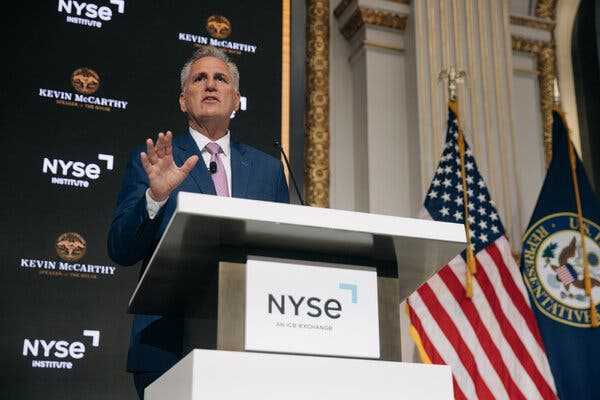Clashing with President Biden, who has called for a debt limit hike with no conditions, the Republican speaker went to Wall Street to pitch what he called a “responsible, sensible” solution.
-
Send any friend a story
As a subscriber, you have “>10 gift articles to give each month. Anyone can read what you share.
Give this article
- 51

Speaker Kevin McCarthy said House Republicans would vote “in the coming weeks” on a measure that would lift the debt ceiling.
WASHINGTON — Speaker Kevin McCarthy on Monday proposed a one-year debt ceiling increase paired with a set of spending cuts and policy changes, backing down substantially from earlier demands but making clear that Republicans would not raise the borrowing limit to avert a catastrophic debt default without conditions.
In a speech delivered from the New York Stock Exchange, Mr. McCarthy said House Republicans would vote “in the coming weeks” on a measure that would lift the debt ceiling into the next year in exchange for freezing spending at last year’s levels while enacting stricter work requirements for social programs and a host of regulatory rollbacks. The plan, which would be dead on arrival in the Senate, would set the stage for yet another fiscal confrontation just as the presidential campaign hits a critical period.
“I’m not predetermining what has to happen,” Mr. McCarthy said in a speech that sought to cast President Biden, who has repeatedly called for a debt-limit increase, as the person standing in the way. “I want a responsible, sensible debt ceiling that puts us on an economic path to make America stronger. It works for every American. But that cannot happen if the president continues to ignore the problem.”
Understand the U.S. Debt Ceiling
Card 1 of 5
What is the debt ceiling? The debt ceiling, also called the debt limit, is a cap on the total amount of money that the federal government is authorized to borrow via U.S. Treasury securities, such as bills and savings bonds, to fulfill its financial obligations. Because the United States runs budget deficits, it must borrow huge sums of money to pay its bills.
The limit has been hit. What now? America hit its technical debt limit on Jan. 19. The Treasury Department will now begin using “extraordinary measures” to continue paying the government’s obligations. These measures are essentially fiscal accounting tools that curb certain government investments so that the bills continue to be paid. Those options could be exhausted by June.
What is at stake? Once the government exhausts its extraordinary measures and runs out of cash, it would be unable to issue new debt and pay its bills. The government could wind up defaulting on its debt if it is unable to make required payments to its bondholders. Such a scenario would be economically devastating and could plunge the globe into a financial crisis.
Can the government do anything to forestall disaster? There is no official playbook for what Washington can do. But options do exist. The Treasury could try to prioritize payments, such as paying bondholders first. If the United States does default on its debt, which would rattle the markets, the Federal Reserve could theoretically step in to buy some of those Treasury bonds.
Why is there a limit on U.S. borrowing? According to the Constitution, Congress must authorize borrowing. The debt limit was instituted in the early 20th century so that the Treasury would not need to ask for permission each time it had to issue debt to pay bills.
”A no-strings-attached debt limit increase will not pass,” he said.
The debt limit is expected to be breached as early as July unless Congress acts to raise it.
The speech came as Republicans, plagued by internal divisions, toil to agree on a fiscal blueprint to accomplish their demand that any such increase be paired with substantial spending cuts. It was unclear whether the proposal Mr. McCarthy laid out on Monday could draw enough support to pass with their slim majority. The outline was significantly narrower than the party’s stated objectives earlier this year that included balancing the budget in 10 years.
Mr. McCarthy’s decision to offer it publicly on Wall Street suggested that the G.O.P. is under growing pressure to produce a plan to calm jitters among investors about the grim outlook for a deal to avert a catastrophic default this summer. Yet he shrugged off such concerns on Monday during a question-and-answer session after his speech, saying, “Markets go up and down.”
“Markets are reacting to work we’ve done,” he said in response to a question about whether he was monitoring market conditions. “So I shouldn’t monitor you; I should monitor what we’re doing.”
More on the Debt Limit
- A Federal Showdown: The United States government is engaged in a high-stakes political battle over paying its debts — again. How did we get here?
- A Solution to the Impasse?: Some Democrats are eying an arcane procedural process as a way to bypass Republicans and ward off a disastrous default. Will it work?
- Staring Down a Debt Crisis: As Speaker Kevin McCarthy works to unite the fractious Republican majority and avert a catastrophe, he has little trust in the man tasked with delivering a budget framework.
- Risks for the Economy: If Congress fails to increase the government’s borrowing limit in time, it could cripple the U.S. economy and cause a shock to financial markets. Here are some of the possible ramifications.
The bill Mr. McCarthy says he is planning to put forward would freeze spending at last fiscal year’s levels, rescind tens of billions of dollars in unspent pandemic relief funds, enact stricter work requirements on food stamp and Medicaid recipients, expand domestic mining and fossil fuel production, and roll back federal regulations Republicans view as overly burdensome.
The Democratic-controlled Senate would refuse to take up the plan, but it would act as House Republicans’ marker for negotiations with the White House.
Mr. Biden and his aides insist that Congress must raise the debt limit without conditions, but they say the president is open to separate discussions on the federal budget — once Mr. McCarthy produces a formal budget proposal. While they wait for Mr. McCarthy to make an offer, White House officials have criticized the budget cuts Republicans have floated, including the work requirements and proposed limits on domestic spending programs.
“A speech isn’t a plan, but it’s clear that extreme MAGA Republicans’ wish lists will impose devastating cuts on hardworking families, send manufacturing overseas, take health care and food assistance away from millions of people and increase energy costs — all while adding trillions to the debt with tax cuts skewed to the super-wealthy and corporations,” Andrew Bates, a White House spokesman, said on Monday.
Source: nytimes.com



